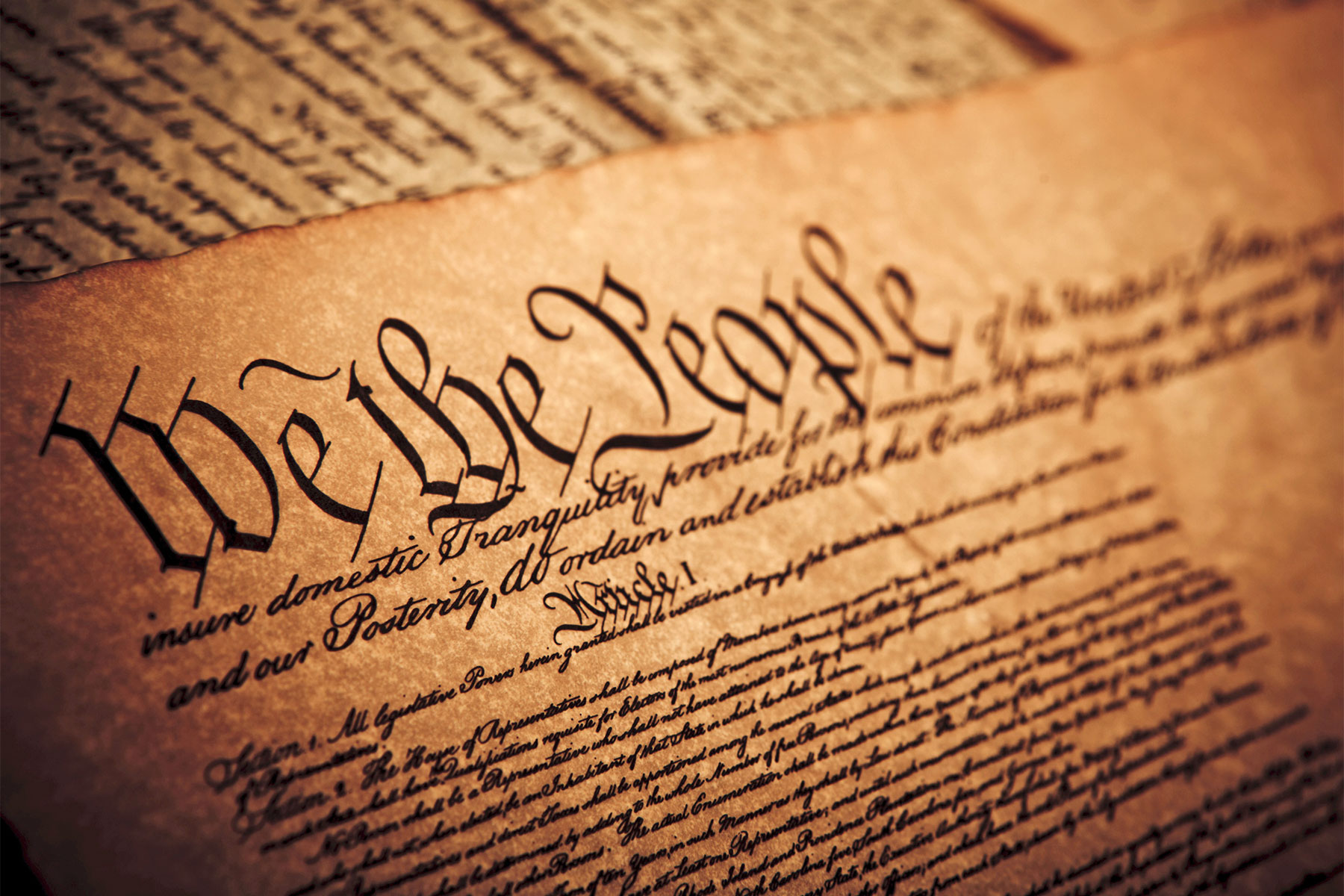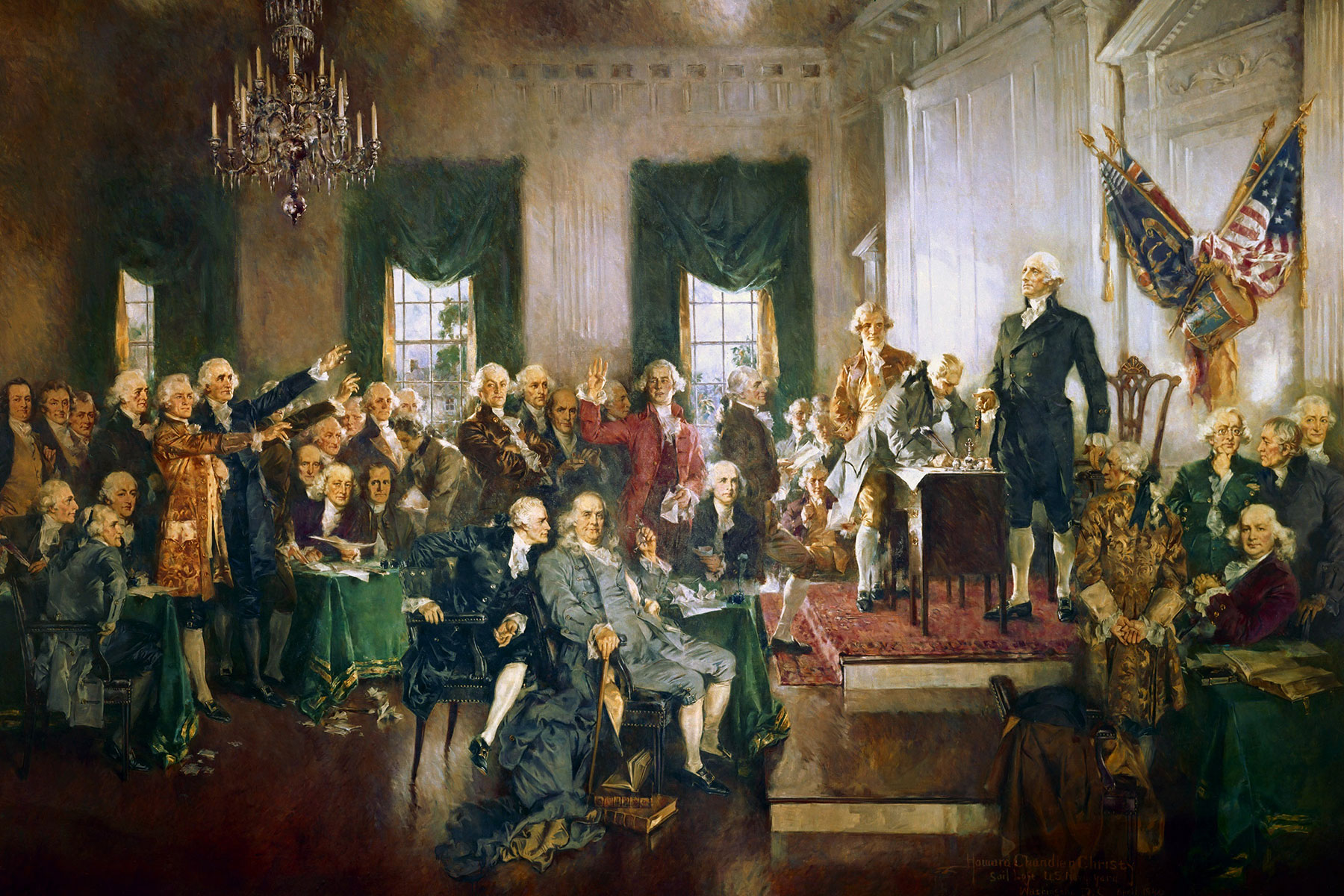
The United States Constitution
Every day it not only asserts and confirms our basic rights. but also sets the contours and controls of our government. Today the founding document of our republic celebrates its 230th birthday.
Constitution Day and Citizenship Day are observed annually to commemorate the signing of the U.S. Constitution on September 17, 1787. [1] Current Congressional resolutions urge civic and local government institutions to plan for the “complete instruction of citizens in their responsibilities and opportunities as citizens of the United States and locally,” and mandates:
1) that the head of every federal agency provide each employee with educational and training materials concerning the Constitution on September 17th; and 2) that each educational institution which receives Federal funds should hold a program for students every September 17th. [2]
In recent years, the Constitution’s currency has been evidenced in its cameo role in the play Hamilton, its 2016 Pocket version ranking on “best sellers” lists for weeks, and its 2017 review by Wisconsin lawmakers deliberating a call for a national Constitutional Convention. Recently the parchment/paper version has been energized and transformed by the National Constitution Center to an interactive website version.
Quarrels abound about interpreting this quill-penned document, but its genius remains unchallenged. What is most remarkable about the U.S. Constitution’s staying power? Is it that the U.S. Constitution even got drafted and adopted by the original states? Is it the underlying tenets and principles that remain largely unchanged – though widely interpreted? Is it due to being one of the oldest surviving constitutions, used as a model by scores of other countries? Or is it that the text continues to play an integral role in the everyday lives of Americans – including right here in the Milwaukee Courts?
Creation and Adoption of the Constitution
Drafting a new Constitution and forming a new government were not the original purposes of the “Constitutional Convention” when it met in May 1787. The delegates met to “fix” the Articles of Confederation – the governing principles of the 13 original states that were put in place at the end of the Revolutionary War. In fact, not every state sent delegates. Rhode Island boycotted the whole convention, determining that it was not in its interest, and it initially refused to ratify the Constitution.
The delegates debated throughout the summer, and were heated beyond the seasonal temperature. They struggled with the balance of power among large states and small states and a centralized federation, with proportionate representation of citizens and of states, with limitation of government generally and of centralized government specifically, with judicial appointing authority, with a controlled amendment process, and with many aspects of slavery – regulation, limitation, citizenship, and the method of “counting” slaves who then constituted about 20 percent of the combined population of the states. Through compromise and courage, the 55 delegates divined and adopted the document – but not unanimously. Three delegates refused to sign. When the necessary number of states ratified it, the U.S. Constitutional government could begin in 1789.
Amendment
The new federal government in short order introduced twelve amendments to the Constitution, and passed ten of them in September 1789. These ten amendments, dubbed “The Bill of Rights,” assured greater protection of individual liberties by detailing prohibitions on governmental power. The first ten amendments were ratified by the necessary number of states by 1791.
Although over 11,000 Amendments have been introduced in Congress, merely 17 more Amendments have been passed – a remarkably few number in 226 years. Of these 17 Amendments:
- Two amendments create and then revoke Prohibition (Amendments 18 and 21);
- Seven Amendments either directly or indirectly relate to voting (Amendments 12, 15, 17, 19, 22, 24 & 26).
- Five Amendments directly relate to the fair trial process. (Amendments 4, 5, 6, 7 and 8).
Ironically the last amendment, ratified in 1992, was introduce in 1789, along with the Bill of Rights. While it took over 202 years for the 27th Amendment to become law, now the Constitution actually provides that Congressional salary changes cannot take effect until after a subsequent election of representatives.
The Constitution as Part of Every Day Lives in Milwaukee.
The Constitution is more than a mechanism to outline the framework of government. It is a means of protecting individual rights. Invoking it keeps the document’s promises fit and muscular, and keeps its application personal. We can see its application locally in the Milwaukee County Courthouse.
The operations of the courthouse advance and accommodate important Constitutional protections. To hear just a criminal case requires the cooperation and coordination of the offices of the Clerk of Courts, the Sheriff, the District Court Administrator, the Chief Judge, Jury Management, facilities, the defense bar and State Public Defender, the District Attorney, the Department of Health Services, and a whole host of support staff. Lots of moving parts also exist for civil, family, probate, and juvenile law cases. The each relevant clause of the Constitution is a throttle that controls court operations.
In 2016, over 112,000 cases were filed in the Milwaukee County Clerk of Courts Office. These thousands of civil and criminal cases are publicly filed, heard by the forty-seven circuit court judges – and a host of court commissioners – and accorded Constitutional due process, as included in the 5th and 14th Amendments and case law. Excepting certain cases afforded privacy protections, all cases are electronically visible on the state court’s website, commonly referred to as CCAP.
Honoring the public trial provisions of the 6th and 7th Amendments, proceedings do not occur or continue when the building’s doors are locked at 5:00 p.m. or on weekends. In 2016, thousands of court hearings and proceedings were held. Jury trials were held in 580 cases – 498 in the Criminal Division, 54 in the Civil Division, and 28 in the Juvenile Division. Of these 580 jury trials, 439 were resolved by jury verdict. Milwaukee County’s longest impaneled jury in 2016 spent twelve days hearing a civil trial.
The jury trial statistics do not include the number of court trials or bench trials held by judges. Nor do they include the thousands of plea hearings or bail hearings held in Milwaukee County’s criminal courts. During these hearings the court confirms and determines that the rights of criminal defendants are upheld under the 4th, 5th, 6th, 7th Amendments and Article III, Sec Two – rights to a fair and speedy public trial by jury, to be notified of accusations, to confront the accuser, to obtain witnesses, and the rights remain silent and prohibit self-incrimination.
Milwaukee County and Wisconsin generally have longstanding, demonstrated commitments to the 6th Amendment Right to Counsel. The 1848 Wisconsin Constitution restated the federal amendment, and the 1859 Wisconsin Supreme Court established that the payment of costs of counsel for criminally charged indigents be borne by the government. In 1957 the Milwaukee Bar Association launched “The Voluntary Defenders Program” – the first of its kind in the nation. This project became a model for public defender programs all over the nation when the U.S. Supreme Court decided the right to counsel, at government expense, in criminal matters of all sorts in the 1963 Gideon v. Wainright case. In fiscal 2016, the Wisconsin State Public Defender appointed counsel throughout the state in 135,543 trial court cases and in 3,315 appellate level cases.
Happy Birthday
The U.S. Constitution was signed 230 years ago not by despots or kings but by “we the people” proclaiming it so. The Constitutional Convention delegates met to fix an awkward confederation. They left with a document for states to ratify a workable, restrained government that would be improved over time by ordinary citizens. Today, as in 1787, it is incumbent on all citizens to continue the Constitution’s purposes: to form a more perfect Union, establish Justice, insure domestic Tranquility, provide for the common defense, promote the general Welfare, and secure the Blessings of Liberty to ourselves and our Posterity.
[1] If September 17th fall on a Sunday the official observance is September 18th.
[2] Public Law 105-225, 112 Stat. 1253 Sec. 106, August 12, 1998, currently codified in 36 USC 106. Consolidated Appropriations Act, 2005, Public Law 108-447, 118 Stat. 2809, Div. J, Title I, Section 111, Dec. 8, 2004, currently codified in 36 USC 106.
“I Am an American Day” (originally celebrated the third Thursday of every May) was established via Joint Resolution authorizing the President of the United States of America to proclaim I Am An American Day, for the recognition, observance, and commemoration of American citizenship, Chapter 183, 54 Stat. 178, May 3, 1940. In 1952 “Citizenship Day” replaced “I Am an American Day” with the goal to “recognize all who, by coming of age or by naturalization, have become citizens.” The 1952 legislation urged “civil and educational authorities of States, counties, cities, and towns… to make plans for the proper observance of Citizenship Day and for the complete instruction of citizens in their responsibilities and opportunities as citizens of the United States and locally,” Joint Resolution designating September 17 of each year as “Citizenship Day,” Chapter 49, 66 Stat. 9, February 29, 1952.















